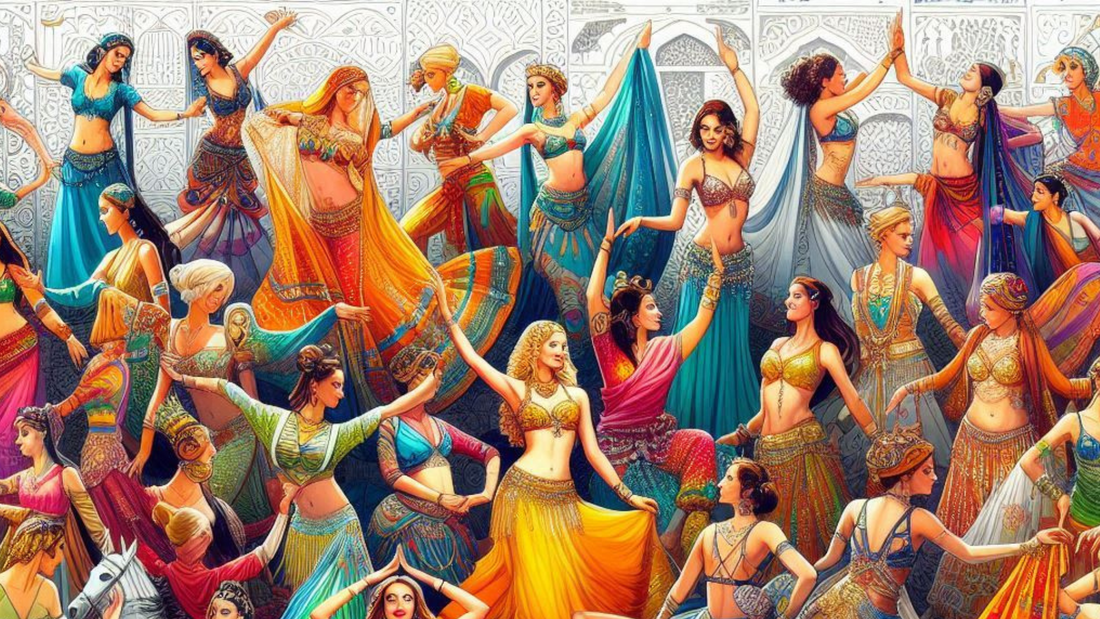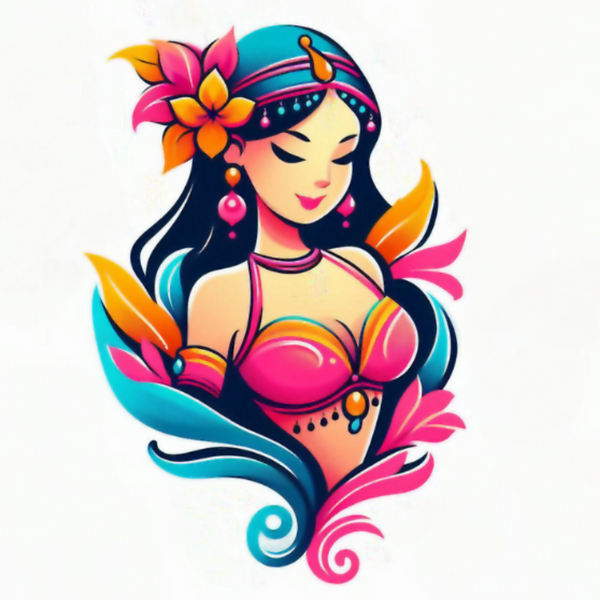
Share
Top 10 Historical Events That Influenced Belly Dance

Belly dancing is a vibrant art form shaped by numerous historical events. The following timeline presents ten unexpected events that have influenced its development, providing a new understanding of its varied and extensive heritage.
1. The Persian Empire's Cultural Exchange (550-330 BCE)
Overview
The Persian Empire was one of the largest and most influential empires in ancient history, spanning regions from the Indus Valley in the east to the Balkans in the west. During this time, the empire facilitated extensive cultural exchanges between different regions under its control. Music, dance, and other art forms traveled along trade routes, influencing the cultures they touched.

Impact
The artistic and cultural exchanges during the Persian Empire era contributed to the development of early dance forms that would later influence belly dance. Persian music and instruments, such as the oud and ney, integrated into Middle Eastern cultural practices, enriching the belly dance repertoire with new rhythms and melodies.

Influence
Persian dances known for their fluidity and grace were incorporated into local dance styles, adding complexity to the movement vocabulary of what would become belly dance. The Persian emphasis on expressive hand and arm movements can still be seen in modern belly dance techniques.

2. The Silk Road Trade Routes (2nd Century BCE - 14th Century CE)
Overview
The Silk Road was a network of trade routes that connected Asia with Europe, facilitating not only the exchange of goods like silk and spices but also ideas, religions, and cultural practices. This exchange included artistic traditions such as dance and music, which traveled along these routes and influenced local cultures.
Impact
The cultural fusion resulting from Silk Road interactions led to the incorporation of various elements into belly dance. Dancers adopted movements and costumes inspired by the diverse cultures encountered along the trade routes, leading to a rich tapestry of influences in the dance form.

Influence
The use of finger cymbals (zills) in belly dance can be traced back to similar instruments used in Central Asian dance traditions, which were introduced to the Middle East via the Silk Road. The trade routes also facilitated the spread of dance costumes adorned with coins and beads, elements that became iconic in belly dance attire.

3. The Islamic Golden Age (8th - 14th Century)
Overview
The Islamic Golden Age was a period of cultural, scientific, and economic flourishing in the Muslim world, characterized by advancements in various fields, including the arts. During this time, the Islamic Empire extended from Spain to India, encompassing a vast array of cultures and traditions.

Impact
The Islamic Golden Age fostered the development and preservation of artistic traditions, including dance. The patronage of the arts by caliphs and wealthy individuals led to the refinement of dance forms, including those that would influence belly dance. The era's emphasis on intellectual and artistic pursuits encouraged the blending of cultural influences.

Influence
The refinement of musical instruments and composition techniques during the Islamic Golden Age contributed to the evolution of the music that accompanies belly dance. Additionally, the era's emphasis on poetry and storytelling influenced the narrative aspects of dance, encouraging performers to convey stories through movement.

4. The Ottoman Empire's Influence (1299–1922)
Overview
The Ottoman Empire was a vast and diverse empire that included regions across the Middle East, North Africa, and Eastern Europe. Under Ottoman rule, cultural exchange was encouraged, and the arts thrived. The empire's multicultural nature allowed for the blending of different dance styles and traditions.

Impact
The Ottoman Empire played a crucial role in spreading belly dance throughout its territories, leading to the development of regional variations. The fusion of Ottoman court dances with local traditions enriched the belly dance repertoire, resulting in a dynamic and evolving art form.

Influence
The introduction of Turkish-style belly dance, known as "Oryantal Dans," during the Ottoman era added new movements and costumes to the dance's vocabulary. The use of veils and elaborate costumes became more prominent, influenced by the opulence of Ottoman court life.

5. The World's Fairs (Late 19th - Early 20th Century)
Overview
World’s Fairs and exhibitions in the late 1800s and early 1900s were pivotal in introducing belly dance to Western audiences. These events featured pavilions showcasing "exotic" cultures, where belly dance was often presented under the label of "danse du ventre" or "Oriental dance."

Impact
The exposure of belly dance at World’s Fairs sparked interest and fascination among Western audiences. However, these events also perpetuated stereotypes and misconceptions about belly dance, often presenting it as a seductive and mysterious dance rather than an art form with deep cultural roots.
Influence
The 1893 Chicago World’s Fair is one of the most famous examples, where dancers like "Little Egypt" introduced belly dance to American audiences. This exposure led to a surge in popularity and curiosity about belly dance in the West, influencing the development of Americanized styles.

6. British Colonization of Egypt (1882-1956)
Overview
British colonization of Egypt marked a significant period of cultural change and Western influence. During this time, Egypt underwent social and economic transformations as Western ideals and practices were introduced. These changes had a profound impact on Egyptian arts, including dance.

Impact
The British influence on Egypt led to the modernization of traditional Egyptian arts, including belly dance. The colonization period saw the commercialization and professionalization of belly dance as it began to be performed in nightclubs and theaters, catering to both local and foreign audiences. This exposure contributed to the global spread of belly dance.
Influence
Dancers began incorporating Western dance elements and theatrical styles into their performances, leading to the development of "raqs sharqi," the modern cabaret style of belly dance. The fusion of Egyptian and Western influences during this time helped shape belly dance into a recognized and celebrated art form worldwide.

7. Egyptian Cinema's Golden Age (1940s-1960s)
Overview
The Golden Age of Egyptian cinema marked a period when the film industry in Egypt flourished, producing films that became popular across the Arab world and beyond. Belly dance was often featured in these films, with dancers like Samia Gamal, Taheya Carioca, and Naima Akef becoming iconic figures.

Impact
Egyptian cinema played a significant role in popularizing belly dance and shaping modern perceptions of the dance. The portrayal of belly dance in films elevated its status and inspired dancers worldwide, contributing to its global appeal.

Influence
The glamorous depictions of belly dancers in films led to a surge in interest in learning and performing the dance outside of Egypt. The association of belly dance with the golden era of Egyptian cinema continues to influence modern performances and styles.

8. The Rise of Tourism in Egypt (20th Century)
Overview
As Egypt became a popular tourist destination, belly dance emerged as a cultural attraction for visitors. Tourists flocked to Egypt to experience its rich history and vibrant culture, including performances by talented belly dancers.

Impact
The rise of tourism increased the visibility of belly dance to international audiences, facilitating cultural exchanges and sparking global interest in the art form. Belly dance became a symbol of Egyptian culture, with performances featured in hotels, nightclubs, and cruise ships along the Nile.

Influence
The demand for belly dance performances in tourist venues led to the professionalization of the art form. Dancers adapted their styles to cater to diverse audiences, incorporating influences from various cultures while maintaining traditional elements.

9. The Feminist Movement (1960s-1970s)
Overview
The feminist movement of the 1960s and 1970s embraced belly dance as a form of female empowerment and self-expression. Women in the West began to learn and perform belly dance, appreciating its focus on the female body in a positive and celebratory manner.

Impact
Belly dance became a symbol of empowerment and body positivity, challenging societal norms and stereotypes about femininity and beauty. The movement contributed to the increased popularity of belly dance in the West, inspiring a new generation of dancers to explore and reinterpret the dance.

Influence
Belly dance classes and workshops gained popularity as women sought to reconnect with their bodies and express themselves through dance. The emphasis on self-expression and empowerment resonated with the feminist ideals of the time, leading to the development of new styles that incorporated elements of modern dance and improvisation.

10. The Arab Spring (2010s)
Overview
The Arab Spring was a series of protests and uprisings across the Middle East and North Africa that brought significant social and political changes to the region. During this time, various forms of art, including music and dance, played crucial roles in expressing the sentiments of the people. One of the most notable cultural phenomena that emerged during this period was Mahragan music, a genre characterized by its energetic beats and socially relevant lyrics.

Impact
The Arab Spring highlighted the role of belly dance as a form of resistance and cultural identity. Dancers used their art to convey messages of solidarity, resilience, and hope, emphasizing the dance's potential for social commentary and change. Mahragan music, with its roots in the streets of Cairo, quickly gained popularity as the soundtrack of the revolution, influencing dance styles and providing a new rhythmic foundation for belly dance performances.

Influence
The rise of Mahragan music during the Arab Spring introduced new sounds and rhythms to the belly dance scene. Performers began incorporating the fast-paced, electronic beats of Mahragan music into their routines, creating dynamic and contemporary interpretations of traditional belly dance. This fusion of modern music and dance highlighted the adaptability and relevance of belly dance in reflecting the social and cultural changes of the time.

The Impact of History
Belly dance's evolution reflects a journey shaped by pivotal historical moments. From the cultural exchanges of the Persian Empire to the modern rhythms of mahragan music during the Arab Spring, each event has played a role in enriching and diversifying this captivating art form. By delving into these significant influences, we uncover the layers of history and culture that contribute to the unique and dynamic nature of belly dance today. This exploration not only deepens our appreciation but also highlights the global journey of a dance that transcends borders and eras.


